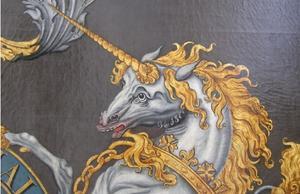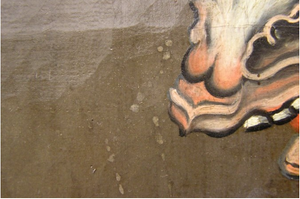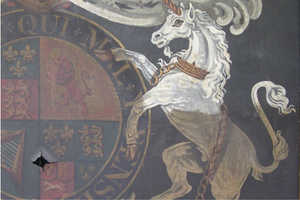Surface Decoration
Looking at Gold, Paint and Varnish
 Very few, if any, Royal Arms have had samples of the paint technically analysed, which means there is very little detailed information about the materials used on this type of painting.
Very few, if any, Royal Arms have had samples of the paint technically analysed, which means there is very little detailed information about the materials used on this type of painting.Visual and historical evidence would indicate that the majority of arms are painted in oils. However, after the accession of Elizabeth II in 1952 acrylic paint may occur.
Sign-writers could be expected to use the standard range of pigments, with a limited use of the more expensive pigments such as ultramarine, orpiment or vermilion. Gold is often used to represent metallic elements, such as crowns and chains, but when cleaning a painting it is also not unusual to find an entirely gilded lion emerge from beneath layers of varnish.
 Where gilding was unaffordable, cheaper yellow ochre would be used in imitation.
Where gilding was unaffordable, cheaper yellow ochre would be used in imitation.The Final Varnish
Most paintings were varnished, both to saturate the paint layer and to add a layer of protection. The latter could be particularly important in a church with a bat population, although no varnish has yet been found that can withstand the damaging effects of bat urine.
Paintings would often be “refreshed” by re-varnishing, but over time these layers darken and discolour, ultimately obscuring the image they were intended to enhance. This is especially true of coach varnish, which
 may indicate an artist’s connection to the coach-painting trade or indicate the value put on such paintings as they did not use picture varnish, which was higher quality.
may indicate an artist’s connection to the coach-painting trade or indicate the value put on such paintings as they did not use picture varnish, which was higher quality.

